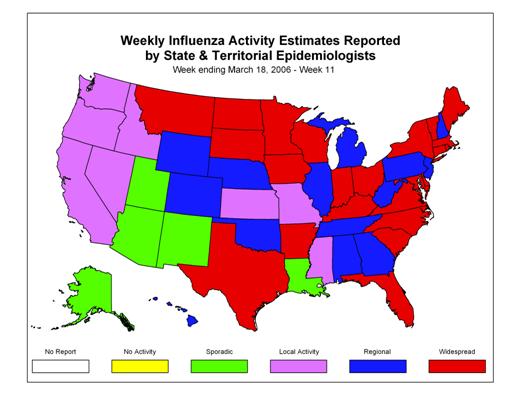Error processing SSI file
Error processing SSI file
Weekly Report: Influenza Summary Update
Week ending March 18, 2006-Week 11
Error processing SSI fileSynopsis:
During week 11 (March 12 ?March 18, 2006)*, influenza activity decreased in the United States. Six hundred fifty-five specimens (21.2%) tested by U.S. World Health Organization (WHO) and National Respiratory and Enteric Virus Surveillance System (NREVSS) collaborating laboratories were positive for influenza. The proportion of patient visits to sentinel providers for influenza-like illness (ILI) was above the national baseline. The proportion of deaths attributed to pneumonia and influenza was below the baseline level. Twenty-three states and New York City states reported widespread influenza activity; 14 states reported regional influenza activity; 8 states and the District of Columbia reported local influenza activity; and 5 states reported sporadic influenza activity.
Laboratory Surveillance*:
During week 11, WHO and NREVSS laboratories reported 3,092 specimens tested for influenza viruses and 655 (21.2%) were positive. Of these, 159 were influenza A (H3N2) viruses, 33 were influenza A (H1N1) viruses, 255 were influenza A viruses that were not subtyped, and 208 were influenza B viruses.
Since October 2, 2005, WHO and NREVSS laboratories have tested a total of 103,188 specimens for influenza viruses and 12,298 (11.9%) were positive. Among the 12,298 influenza viruses, 11,049 (89.8%) were influenza A viruses and 1,249 (10.2%) were influenza B viruses. Four thousand five hundred seventy-eight (41.4%) of the 11,049 influenza A viruses have been subtyped: 4,404 (96.2%) were influenza A (H3N2) viruses and 174 (3.8%) were influenza A (H1N1) viruses. All states have reported laboratory-confirmed influenza this season. During the past 3 weeks (weeks 9?1), the percentage of specimens testing positive for influenza has ranged from 34.0% and 30.4% in the South Atlantic and East South Central regions, respectively, to 12.9% in the Pacific region**. The percentage of influenza isolates identified as influenza type B viruses continued to increase in the United States. During weeks 9?1, 60.4% of isolates from the Mountain region have been influenza B. The influenza B isolates reported from this region accounted for 39.3% of the B isolates reported during this time period. Other regions reporting more than 30.0% of recent isolates as influenza B include the West North Central and West South Central regions.
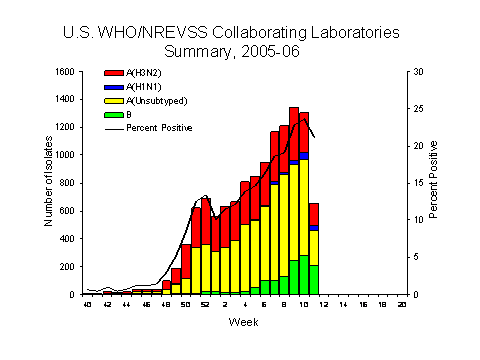
View
Chart Data |
View
Full Screen
Composition of the 2006-07 Influenza Vaccine:
WHO has recommended that the 2006-07 trivalent influenza vaccine for the Northern Hemisphere contain A/New Caledonia/20/99-like (H1N1), A/Wisconsin/67/2005-like (H3N2), and B/Malaysia/2506/2004-like viruses. The influenza A (H3N2) and the influenza B components have been changed from the 2005-06 season vaccine components. A/Wisconsin/67/2005 is an antigenic variant of the current vaccine strain A/California/07/2004. Influenza B viruses currently circulating can be divided into two antigenically distinct lineages represented by B/Yamagata/16/88 and B/Victoria/2/87 viruses. The updating of the influenza B component to B/Ohio/1/2005 (which is antigenically equivalent to B/Malaysia/2506/2004) represents a change to the B/Victoria lineage. This recommendation was based on antigenic analyses of recently isolated influenza viruses, epidemiologic data, and post-vaccination serologic studies in humans.
Antigenic Characterization:
CDC has antigenically characterized 395 influenza viruses [325 influenza A (H3N2), 18 influenza A (H1), and 52 influenza B viruses] collected by U.S. laboratories since October 1, 2005. Of the 325 influenza A (H3N2) viruses, 261 were characterized as A/California/07/2004-like, which is the influenza A (H3N2) component recommended for the 2005-06 influenza vaccine, and 64 viruses showed reduced titers with antisera produced against A/California/07/2004. Of the 64 low-reacting viruses, 38 were tested with antisera produced against A/Wisconsin/67/2005 (the H3N2 component selected for the 2006-07 vaccine), and 34 are A/Wisconsin-like. The hemagglutinin proteins of 16 influenza A (H1) viruses were similar antigenically to the hemagglutinin of the vaccine strain A/New Caledonia/20/99, and 2 showed reduced titers with antisera produced against A/New Caledonia/20/99. Twenty-four of the influenza B viruses that have been characterized belong to the B/Yamagata lineage. Four were similar to B/Shanghai/361/2002, the recommended influenza B component for the 2005-06 influenza vaccine, and 20 were characterized as B/Florida/07/2004-like. B/Florida/07/2004 is a minor antigenic variant of B/Shanghai/361/2002. Twenty-eight influenza B viruses were identified as belonging to the B/Victoria lineage and all were similar to B/Ohio/1/2005, the influenza B component selected for the 2006-07 vaccine.
Pneumonia and Influenza (P&I) Mortality Surveillance*:
During week 11, 7.8% of all deaths reported by the vital statistics offices of 122 U.S. cities were due to pneumonia or influenza. This percentage is below the epidemic threshold of 8.2% for week 11.
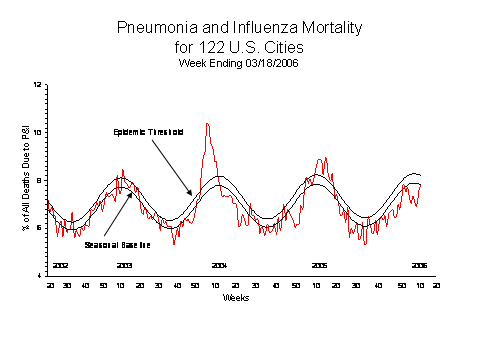
Influenza-Associated Pediatric Mortality*:
No influenza-associated pediatric deaths were reported during week 11. Since October 2, 2005, CDC has received reports of 16 influenza-associated pediatric deaths, 14 of which occurred during the current influenza season.
Influenza-Associated Pediatric Hospitalizations*:
Laboratory-confirmed influenza-associated pediatric hospitalizations are monitored in two population-based surveillance networks?/sup>: the Emerging Infections Program (EIP) and the New Vaccine Surveillance Network (NVSN). During October 1, 2005 ?March 4, 2006, the preliminary influenza-associated hospitalization rate reported by the EIP for children aged 0-17 years was 0.60 per 10,000. For children aged 0-4 years and 5-17 years, the rate was 1.44 per 10,000 and 0.19 per 10,000, respectively. During October 30, 2005 ?March 4, 2006, the preliminary laboratory-confirmed influenza-associated hospitalization rate for children aged 0-4 years in the NVSN was 2.1 per 10,000. EIP and NVSN hospitalization rate estimates are preliminary and may change as data continue to be collected.
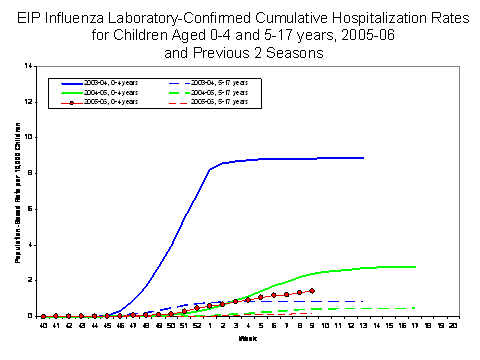
View
Full Screen
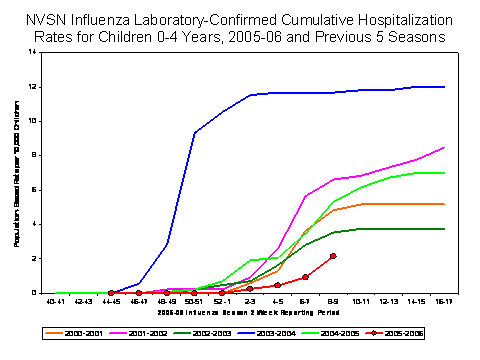
View
Full Screen
Influenza-like Illness Surveillance*:
During week 11, 2.5%*** of patient visits to U.S. sentinel providers were due to ILI. This percentage is above the national baseline of 2.2%. The percentage of visits for ILI ranged from 1.3% in the Pacific region to 3.6% in the West South Central region. Due to wide variability in regional level data, it is not appropriate to apply the national baseline to regional level data.
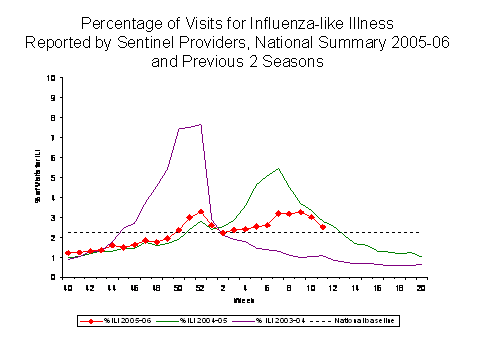
View
Chart Data
| View Full Screen
Influenza Activity as Assessed by State and Territorial Epidemiologists*:
During week 11, 23 states (Arkansas, Connecticut, Delaware, Florida, Indiana, Iowa, Kentucky, Maine, Maryland, Massachusetts, Minnesota, Montana, New York, North Carolina, North Dakota, Ohio, Rhode Island, South Carolina, South Dakota, Texas, Vermont, Virginia, and Wisconsin) and New York City reported widespread influenza activity. Fourteen states (Alabama, Colorado, Georgia, Hawaii, Illinois, Michigan, Nebraska, New Hampshire, New Jersey, Oklahoma, Pennsylvania, Tennessee, West Virginia, and Wyoming) reported regional influenza activity. Eight states (California, Idaho, Kansas, Mississippi, Missouri, Nevada, Oregon, and Washington) and the District of Columbia reported local influenza activity. Five states (Alaska, Arizona, Louisiana, New Mexico, and Utah) reported sporadic influenza activity.
--------------------------------------------------------------------------------
Report prepared March 24, 2006
Error processing SSI file